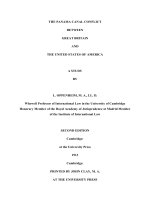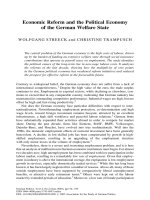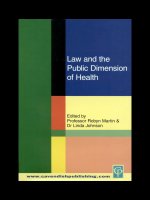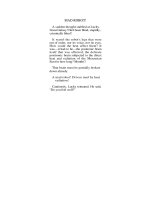Stress and obstructive airway diseases association and the mediating role of neuropeptide y
Bạn đang xem bản rút gọn của tài liệu. Xem và tải ngay bản đầy đủ của tài liệu tại đây (2.15 MB, 163 trang )
STRESS AND OBSTRUCTIVE AIRWAY DISEASES:
ASSOCIATION AND THE MEDIATING ROLE OF
NEUROPEPTIDE Y
LU YANXIA
(MASTER OF EDUCATION)
A THESIS SUBMITTED
FOR THE DEGREE OF DOCTOR OF PHILOSOPHY
DEPARTMENT OF PSYCHOLOGICAL MEDICINE
NATIONAL UNIVERSITY OF SINGAPORE
2014
2
I
ACKNOWLEDGEMENT
I would like to express my deepest gratitude first and foremost to Associate Professor Ng Tze Pin, for
his constant encouragement and instructions in the past four years. As a knowledgeable and
dedicated supervisor, he has walked me through all the stages of the research and study of this
exciting and hard journey. It is impossible for me to complete this PhD thesis without his expertise,
encouragement, and concrete support.
I am also deeply indebted to my co-supervisors Doctor Roger Ho Chun Man, Professor Hugo PS Van
Bever, and Associate Professor Wong Wai Shiu Fred for their full support and specific guidance.
From them, I learnt a lot about psycho-neuro-immunology from the perspectives of multiple
disciplines.
I wish to give cordial thanks to all the team members of the Gerontology Research Programme (GRP,
NUS), the staffs in Department of Psychological Medicine (PCM, NUS), for all your help, support,
and instructions.
I would express my special thanks to my beloved parents, my sisters, and my boyfriend for their
loving considerations, great confidence in me, and continuous support through these years, especially
during my low tide time.
Finally, my thanks would go to National University of Singapore for awarding me the NUS Research
Scholarship which makes all those research activities possible. I wish I will be able to contribute
more to Singapore as well as the academic world when I continue my academic life in this promising
country.
II
LIST OF PUBLICATIONS
1. Lu YX, Ho RC, Lim TK, Kuan WS, Goh DY, Mahadevan M, Sim TB, van Bever HP, Larbi
A, Ng TP. Neuropeptide Y may mediate psychological stress and enhance Th2 inflammatory
response in asthma. J Allergy Clin Immunol. 2015; in press.
2. Lu YX, Feng L, Feng L, Nyunt MS, Yap KB, Ng TP. Systemic inflammation, depression and
obstructive pulmonary function: a population-based study. Respir Res. 2013;14:53.
3. Lu YX, Mak KK, van Bever HP, Ng TP, Mak A, Ho RC. Prevalence of anxiety and
depressive symptoms in adolescents with asthma: a meta-analysis and meta-regression.
Pediatr Allergy Immunol. 2012;23:707-15.
4. Lu YX, Ho RC, Lim TK, Kuan WS, Goh DY, Mahadevan M, Sim TB, Ng TP, van Bever HP.
Psychiatric comorbidities in Asian adolescent asthma patients and the contributions of
neuroticism and perceived stress. J Adolesc Health. 2014;14:1-9.
5. Lu YX, Feng L, Lim L, Ng TP. Asthma, life events and psychiatric disorders: a population-
based study. Soc Psychiatry Psychiatr Epidemiol. 2013;48:1273-82.
6. Lu YX, Nyunt MS, Gwee X, Feng L, Feng L, Kua EH, Kumar R, Ng TP. Life event stress
and chronic obstructive pulmonary disease (COPD): associations with mental well-being and
quality of life in a population-based study. BMJ Open. 2012;2.
7. Lu YX, Tang C, Liow CS, Ng WN, Ho SH, Ho RC. A regressional analysis of maladaptive
rumination, illness perception and negative emotional outcomes in Asian patients suffering
from depressive disorder. Asian J Psychiatr. 2014;12:69-76.
8. Lu YX, Ho RC, Lim TK, Kuan WS, Goh DY, Mahadevan M, Sim TB, van Bever HP, Larbi
A, Ng TP. Obesity, inflammatory cytokines, adiponectin and neuropeptide Y: associations
with asthma prevalence and Th2-cytokine (interleukin-4) marker of allergic airway
inflammation. To be submitted.
9. Lu YX, Ho RC, Lim TK, Kuan WS, Goh DY, Mahadevan M, Sim TB, van Bever HP, Larbi
A, Ng TP. Neuropeptide Y polymorphism and adiposity in asthma during a one-year
prospective follow-up. To be submitted.
III
CONTENTS
ACKNOWLEDGEMENT
I
LIST OF PUBLICATIONS
II
ABSTRACT
IX
LIST OF TABLES
XIII
LIST OF FIGURES
XIV
LIST OF ABBRIVIATIONS
XV
1. INTRODUCTION
1
1.1 Obstructive airway disease and its burden to society
1
1.2 Psychiatric comorbidity in obstructive airway disease
2
1.3 Psychological stress and airway obstruction
3
1.4 Objectives of the current study
4
2. LITERATURE REVIEW
7
2.1 Psychological stress and airway obstruction
7
2.1.1 Psychological stress
7
2.1.2 Psychological stress and asthma exacerbation
9
2.1.3 Psychological stress and asthma onset
10
IV
2.1.4 Psychological stress and COPD
12
2.1.5 Underlying mechanism
12
2.2 Inter-individual variability of stress and asthma
14
2.2.1 Age characteristics of asthma
14
2.2.2 Inter-individual variability of stress
17
2.3 Neuropeptide Y and inter-individual variability in stress-asthma link
19
2.3.1 Structure and function of Neuropeptide Y
20
2.3.2 Neuropeptide Y and psychological stress
21
2.3.3 Neuropeptide Y and inter-individual variability of stress in asthma
22
3. METHODS
24
3.1 Study I: Prevalence of anxiety and depressive symptoms in adolescents with asthma:
a meta-analysis and meta-regression
24
3.1.1 Search strategy
24
3.1.2 Criteria for article selection
24
3.1.3 Data abstraction
25
3.1.4 Statistical analyses
25
3.2 Study II: Asthma control, perceived stress, and quality of life in adolescents with
26
V
asthma: a case-control study
3.2.1 Study design and participants
26
3.2.2 Asthma control and asthma quality of life
27
3.2.3 Depression and anxiety
28
3.2.4 Stressful life events and perceived stress
28
3.2.5 Socio-demographic data and self-rated health
29
3.2.6 Statistical analyses
30
3.3 Study III: Asthma, psychological stress and psychiatric morbidity: a population-
based study in adult Singaporeans
31
3.3.1 Study design and participants
31
3.3.2 Asthma and other chronic physical conditions
31
3.3.3 Psychiatric disorders
33
3.3.4 Stressful life events and quality of life
34
3.3.5 Statistical analyses
35
3.4 Study IV: The impact of stressful life events on quality of life in the elderly with
airway obstruction
36
3.4.1 Study design and participants
36
VI
3.4.2 Airway obstruction
37
3.4.3 Stressful life events and depressive symptoms
37
3.4.4 Cognitive function
38
3.4.5 Physical and mental functioning
38
3.4.6 Statistical analyses
39
3.5 Study V: Stress, neuropeptide Y, and young adult asthma: a follow-up study
40
3.5.1 Study design and participants
40
3.5.2 Spirometric test
41
3.5.3 Questionnaire administration
41
3.5.4 Enzyme-linked immunosorbent assay (ELISA) and Multiplex analysis
43
3.5.5 Socio-demographic data and clinical profile
44
3.5.6 Statistical analyses
44
4. RESULTS
46
4.1 Study I: Prevalence of anxiety and depressive symptoms in adolescents with asthma:
a meta-analysis and meta-regression
46
4.1.1 Aggregate prevalence and pooled odds ratio of depressive symptoms in
adolescents with asthma versus the healthy controls
46
VII
4.1.2 Aggregate prevalence and pooled odds ratio of anxiety symptoms in
adolescents with asthma versus the healthy controls
49
4.2 Study II: Asthma control, perceived stress, and quality of life in adolescents with
asthma: a case-control study
53
4.2.1 Demographics
53
4.2.2 Asthma control
53
4.2.3 Psychiatric comorbidities
53
4.2.4 Contribution of perceived stress to psychiatric comorbidity
54
4.3 Study III: Asthma, psychological stress and psychiatric comorbidity: a population-
based study in adult Singaporeans
63
4.3.1 Study participants
63
4.3.2 Comorbidity of psychiatric disorders with asthma and other chronic physical
conditions
63
4.3.3 Stressful life events as a mediating factor for psychiatric comorbidity
67
4.3.4 Relative contribution of stressful life events and concurrent psychiatric
disorders to impaired quality of life
68
4.4 Study IV: The impact of stressful life events on quality of life in the elderly with
airway obstruction
72
4.5 Study V: Stress, neuropeptide Y, and young adult asthma: a follow-up study
77
VIII
5. DISCUSSION
84
5.1 Study I: Prevalence of anxiety and depressive symptoms in adolescents with asthma:
a meta-analysis and meta-regression
84
5.1.1 Higher prevalence of depressive symptoms among adolescents with asthma
84
5.1.2 Higher prevalence of anxiety symptoms among adolescents with asthma
86
5.2 Study II: Asthma control, perceived stress, and quality of life in adolescents with
asthma: a case-control study
88
5.3 Study III: Asthma, psychological stress and psychiatric comorbidity: a population-
based study in adult Singaporeans
91
5.4 Study IV: The impact of stressful life events on quality of life in the elderly with
airway obstruction
94
5.5 Study V: Stress, neuropeptide Y, and young adult asthma: a follow-up study
98
6. SUMMARY AND CONCLUSION
104
7. REFERENCES
108
APPENDIX
122
IX
ABSTRACT
Background: The prevalence of obstructive airway diseases such as asthma and chronic obstructive
pulmonary disease (COPD) has increased significantly in recent decades, concurrently with
increasing mental health problems worldwide. However, the underlying mechanisms especially the
relative contribution of psychological stress to the psychiatric co-morbidities and functioning
impairment observed in obstructive airway diseases are not well elucidated.
Objective: This study aims to explore the stress-airway obstruction association in adolescent, adult
and elderly individuals, and the underlying role of neuropeptide Y (NPY) through a cross-sectional
clinical study, a clinical follow-up study and population-based studies.
Methods: A systematic meta-analysis and meta-regression was performed about the prevalence of
anxiety and depressive symptoms in adolescents with asthma in Study I. The stress-asthma link was
investigated in a clinical study (Study II) of adolescents with well controlled asthma (n = 137),
poorly controlled asthma (n = 61), and healthy neighbourhood controls (n = 171). Questionnaires
were administered to explore the symptom profile of specific anxiety and depressive comorbidity
(panic attacks, social phobia, generalized anxiety, obsession and compulsion, separation anxiety,
depression, total anxiety and total internalizing symptoms (anxiety and depressive)) in adolescents
with asthma and the role of perceived stress in explaining the association between asthma and
psychiatric comorbidity. In Study III, data in a nationally representative sample of Singaporean
adults aged 20-59 (n = 2847) were analysed for asthma, other chronic physical conditions (e.g.,
coronary heart disease, stroke, lipid abnormalities), and no chronic physical conditions. Participants
were assessed for stressful life events, psychiatric disorders, and quality of life. Population-based
data were analysed for a sample (n = 497) of older persons aged 65 and above (Singapore
Longitudinal Ageing Study (SLAS), Study IV) with airway obstruction (post-bronchodilatation
X
FEV1/FVC < 0.70, n = 136) or without airway obstruction (n = 277). The main effects of stressful
life events and airway obstruction, and their interaction, on measures of pulmonary function,
depressive symptoms (Geriatric Depression Scale), cognitive function (Cognitive Failures
Questionnaire and Mini-Mental State Examination), and quality of life were investigated. Study V
investigated the association of measures of psychological and biological stress with T helper cell type
(Th)2 expression of Interleukin-4 (IL-4), a cytokine marker of allergic airway inflammation in
asthma and the potential mediating role of NPY in this association among 70 young adult (21-35
years old) acutely exacerbated and non-exacerbated chronic asthma patients, and 69 age- and gender-
matched healthy controls. The participants were assessed for the levels of perceived stress (Perceived
Stress Scale), hypothalamo-pituitary-adrenal (HPA) hormones, adrenocorticotropic hormone
(ACTH), adrenaline (A), noradrenaline (NA), cortisol, NPY and IL-4 (measured at baseline and 12-
month follow-up).
Results: Study I showed that the aggregate prevalence of depressive and anxiety symptoms was
significantly higher among 3,546 adolescents with asthma than that of 24,884 healthy controls
(Depression: 0.27; 95% CI: 0.18.6-0.39 vs. 0.13; 95% CI: 0.09-0.19; Anxiety: 0.33; 95% CI: 0.19-
0.52 vs. 0.21; 95% CI: 0.12-0.33). The risk of developing depression and anxiety was significantly
higher among adolescents with asthma when compared with the healthy controls (depression: OR =
2.09, p < 0.001; anxiety: OR = 1.83, p < 0.001). Meta-regression revealed that the proportions of
Caucasian (p < 0.01) and smokers (p < 0.001) were significant moderators which explained the
significant heterogeneity when comparing the risk of developing depressive symptoms among
adolescent asthma patients versus the healthy controls while age, gender and severity of asthma were
not significant. In Study II, adolescents with poorly controlled asthma, compared with well
controlled asthma patients and the healthy controls, had higher scores of depression (p = 0.006),
panic attacks (p = 0.002), total anxiety (p = 0.038) and total internalizing symptoms (p = 0.017), as
XI
well as perceived stress (p = 0.022), after adjusting for potential confounders. Perceived stress
explained to a great extent the psychiatric comorbidity scores both in the whole sample and in asthma
patients. Study III found that the asthma group reported significantly more stressful life events than
individuals with other chronic medical conditions (OR = 2.93) and the healthy controls (OR = 4.88).
Among individuals with asthma, stressful life events contributed significantly towards increased
psychiatric comorbidity and worse SF-12 Mental Component Summary functioning scores. In the
elderly (Study IV), stressful life events were found to be associated with more depressive symptoms
(Main effects
stress
: F = 64.500, p < 0.001; Main effects
airway obstruction
: F = 2.353, p = 0.126; Interaction:
F = 10.970, p = 0.001) and worse physical (Main effects
stress
: F = 7.054, p = 0.008; Main effects
airway
obstruction
: F = 0.432, p = 0.512; Interaction: F = 4.055, p = 0.045) and mental functions (Main effects
stress
: F = 14.710, p < 0.001; Main effects
airway obstruction
: F = 0.659, p = 0.417; Interaction: F = 4.538, p
= 0.034) in participants with airway obstruction than in those without airway obstruction after
adjusting for potential confounders. In Study V, higher levels of perceived stress, corroborated by
elevated levels of ACTH, NA, A, derived HPA stress index, and depressed cortisol were observed in
patients with asthma than with healthy controls (p < 0.05). NPY levels congruent with chronic stress
exposure was lower in asthma patients versus controls (p = 0.01). Among asthma patients, perceived
stress and NPY were significantly and positively associated with elevated IL-4 levels at baseline and
1-year follow up. NPY significantly mediated the association of psychological stress with IL-4
(Sobel tests: p = 0.033, baseline IL-4; p = 0.032, IL-4 one year later). The HPA index measure of
transient biological stress, independent of NPY, was a significant predictor of IL-4 at baseline but not
at one-year follow up.
Conclusions: Results of the present thesis suggest the pivotal role of psychological stress to the
association of psychological symptoms and obstructive airway diseases. NPY may be a plausible
XII
neuroendocrine mediator for the persistent effect of perceived stress on heightening Th2 immune and
inflammatory responses in asthma, and a candidate for early targeted interventions.
XIII
LIST OF TABLES
Table 1. Study design and baseline characteristics of studies included in meta-analysis
48
Table 2. Meta-regression analysis of potential moderators to explain heterogeneity of
prevalence of depressive symptoms
52
Table 3. Socio-demographic characteristics, psychological functioning, clinical profiles
and psychiatric comorbidity of adolescents with and without asthma
57
Table 4. Adjusted mean ± standard error symptom scores of psychiatric comorbidity
among poorly controlled and well controlled asthma patients, and healthy adolescents:
hierarchical regression models
59
Table 5. Correlation coefficients of asthma, psychological and psychiatric variables
60
Table 6. Analyses of perceived stress and asthma control score as predictors of psychiatric
comorbidity among asthma patients in regression models
62
Table 7. Socio-demographic and clinical characteristics of adults aged 20-59 by asthma,
other chronic physical conditions, and no chronic physical conditions groups in Singapore
(National Mental Health Survey 2003)
64
Table 8. Prevalence (%) of psychiatric disorders and stressful life events, by asthma, other
chronic physical conditions and no chronic physical conditions groups
65
Table 9. Association of asthma and other chronic physical conditions with measures of
coexisting psychiatric disorders and stressful life events
66
Table 10. Sobel test of the mediation of stressful life events on the coexistence of
psychiatric disorders with asthma and with other chronic physical conditions
70
Table 11. Quality of life among asthma, other chronic physical conditions and no chronic
physical conditions groups, and relative contributions from stressful life events and
coexisting psychiatric disorders
71
Table 12. Socio-demographic, pulmonary and psychological variables of study participants
aged 65 or older (Singapore Longitudinal Aging Study, SLAS-2)
74
Table 13. Two-way ANCOVA: Stressful life events, airway obstruction and mental and
physical variables
75
XIV
Table 14. Socio-demographic, clinical, and psychological characteristics of young adults
aged 21-35 years by acute asthma, chronic asthma, and healthy control
80
Table 15. Measurements of IL-4 and stress-related variables in young adults aged 21-35
years by acute asthma, chronic asthma, and healthy control
81
Table 16. Correlations of psychological and biological stress variables with IL-4 level
82
Table 17. Independent associations and mediational analyses of measures of perceived and
HPA stress and NPY with IL-4 concentrations among patients with asthma
83
LIST OF FIGURES
Figure1. Flowchart describing the process of study selection in meta-analysis
47
Figure 2. Forest plots of the aggregate prevalence of depressive and anxiety symptoms in
adolescents with asthma and the healthy controls
50
Figure 3. Forest plot of the pooled odd ratio of depressive and anxiety symptoms in
adolescents with asthma versus the healthy controls
51
Figure 4. Association of asthma control with psychiatric comorbidity in adolescents with
asthma
61
Figure 5. Stressful life events and mental and functional well-being among study
participants with or without airway obstruction
76
XV
LIST OF ABBREVIATIONS
A
Adrenaline
AAI
Allergic airway inflammation
ACT
Asthma Control Test
ACTH
Adrenocorticotrophic hormone
ANCOVA
Analysis of covariance
ANOVA
Analyses of Variance
APCs
Antigen-presenting cells
AQLQ
Asthma Quality of Life Questionnaire
ATP
Adenosine Triphosphate
ATS
American Thoracic Society
BMI
Body Mass Index
CBT
Cognitive behavioural therapy
CFQ
Cognitive Failures Questionnaire
COPD
Chronic obstructive pulmonary disease
CRH
Corticotropin-releasing hormone
CSF
Cerebrospinal fluid
XVI
df
Degree of freedom
DHEA
Dehydroepiandrosterone
DSM-IV
Diagnostic and Statistical Manual of Mental Disorders, Fourth Edition
DSRB
Domain Specific Review Board
ELISA
Enzyme-linked immunosorbent assay
EMD
Emergency Medicine Department
FeNO
Fractional exhaled nitric oxide
FEV1
Forced expiratory volume in 1 second
FFI
Five-Factor Inventory
FFM
Five-Factor Model
FVC
Forced vital capacity
GAD
Generalized anxiety disorder
GDS-15
15-item Geriatric Depression Scale
GHQ
General Health Questionnaire
GOLD
The Global Initiative for Chronic Obstructive Lung Disease
HADS
Hospital Anxiety and Depression Scale
HPA
Hypothalamo-pituitary- adrenocortical
XVII
ICS
Inhaled corticosteroids
IgE
Immunoglobulin E
IL
Interleukin
LTB4
Leukotriene B4
LTEQ
List of Threatening Experiences Questionnaire
MCS
Mental Component Summary
MDD
Major depressive disorder
MMSE
Mini-Mental State Examination
mRNA
Messenger ribonucleic acid
NA
Noradrenaline
NHLBI
National Heart Lung and Blood Institute
NMHS (A)
National Mental Health Survey (Adults)
NPY
Neuropeptide Y
NUH
National University Hospital
OR
Odds ratio
PAQLQ
Paediatric Asthma Quality of Life Questionnaire
PASW
Predictive Analytics Software
XVIII
PCS
Physical Component Summary
PSS
Perceived Stress Scale
PTSD
Posttraumatic stress disorder
QoL
Quality of life
RCADS
Revised Child Anxiety and Depression Scale
RCCM
Respiratory and Clinical Care Medicine
SAM
Sympathetic-adrenomedullary
SCAN
Schedule for Clinical Assessment in Neuropsychiatry
SE
Standard error
SF-12
Medical Outcomes Study 12-item Short Form
SF-36
Medical Outcomes Study 36-item Short Form
SLAS
Singapore Longitudinal Ageing Study
SNP
Single nucleotide polymorphism
SRH
Self-rated health
SRRS
Social Readjustment Ratings Scale
TGN
Trans-Golgi network
Th
T helper cell type
XIX
TNF-α
Tumor necrosis factor alpha
1
CHAPTER 1 INTRODUCTION
Asthma affects over 300 million people worldwide. Chronic obstructive pulmonary disease (COPD)
will rank the fifth in the global burden of disease by 2020.
1
The increased prevalence of obstructive
airway diseases is occurring concurrently with increasing mental health problems and impaired
quality of life. The connection between stress and airway obstruction has vast aetiological
significance, and may represent the next leap in advancing knowledge about airway disease aetiology,
prevention and treatment. This thesis focused on aspects of the contribution of psychological stress to
the psychiatric comorbidity of airway obstruction in different age groups including adolescent, adult
and the elderly individuals, as well as the role of neuropeptide Y (NPY) in mediating the persistent
effect of perceived stress on heightening T helper cell type (Th)2 immune and inflammatory
responses in asthma. Research into the role of neuropeptides in the inter-individual variability in
stress-airway obstruction connection will greatly enhance the understanding of asthma
pathophysiology from a psycho-neuro-immunological perspective. Chapter 1 presented the general
background and context of the current study. More detailed literature review was covered in Chapter
2.
1.1 Obstructive airway disease and its burden to society
Obstructive airway diseases such as asthma and COPD are a category of respiratory diseases
characterized by airway obstruction. It is generally distinguished by inflamed and easily collapsible
airways, airflow obstruction, problems with exhaling and frequent physician and Emergency
Medicine Department (EMD) visits and hospitalizations.
2
Obstructive airway disease has shown
increasing prevalence in various populations. Among the adult population, the reported prevalence of
2
asthma varies from 1.9% in Greece to 18.4% in Scotland.
3
In the United States, the mortality for
COPD doubled since 1970 to 2002 and currently ranks the fourth leading cause of death.
4
In
Singapore, the prevalence of asthma is 10.2% in children and 11.9% in adolescents.
5
COPD
accounts for 4.7% of all deaths and 1.2% of all hospitalizations, which is much higher than in the
United States, Canada and other countries.
6
Asthma and COPD pose significant psycho-social, economic and health care burdens to the patients,
their families and the society.
3, 7
Notably, the concurrent poor mental health of patients with airway
obstruction has received growing attention in recent decades, as increasing numbers of studies
8-10
have reported that psychological factors, particularly anxiety and depressive symptoms, are even
better predictors of obstructive airway disease-related functional impairment and quality of life (QoL)
than lung function. Patients with severe airway obstruction experience various difficulties with
emotional functioning, sleep and rest, physical mobility, social interaction and daily activities.
Notably, extensive literature describes the extreme stress and anxiety provoking experience of
dyspnea in asthma and COPD.
11, 12
During exacerbation episodes, feelings of suffocating, strangling
or drowning are associated with heightened emotions, growing panic, extreme fear, muddled
thoughts, and decreased physical energy.
11
The increased prevalence and severity of airway
obstruction amidst the background of increasing mental health problems call for research into the
relationship between stress and obstructive airway diseases.
1.2 Psychiatric comorbidity in obstructive airway disease
3
Among obstructive airway diseases, asthma has historically long been considered as a typical
psychosomatic disorder.
13
Asthma, along with other obstructive airway diseases, is associated with a
high comorbidity with psychiatric disorders such as anxiety, depression, panic attacks, and
posttraumatic stress disorder (PTSD).
14-16
Vazquez et al.
17
found that patients with near-fatal asthma
showed higher psychological morbidity, notably anxiety, even years after the near-fatal asthma
episode. Among adults with asthma and COPD, the co-occurrence of an anxiety or depressive
disorder is associated with adverse outcomes such as poor symptom control, impaired QoL, and
increased health care utilization.
18, 19
The mechanisms underlying the psychiatric comorbidity in asthma and COPD are not well
understood.
20, 21
It remains unclear to what extent individual psychiatric comorbidity results uniquely
from specific or common biological responses, or from psychological factors such as environmental
stress and poor coping which may reduce psychological dysfunction. In particular, the relative
contribution of psychological stress to the aetiology of psychiatric comorbidities in asthma and
COPD is not fully investigated.
1.3 Psychological stress and airway obstruction
Patients with asthma and COPD may experience various stressful life events and psychosocial
adversities such as withdrawal from family or social life, social isolation, inability to work,
unemployment, interpersonal problems, low self-esteem, financial loss, poor mental health, and
reduction of social functioning and life satisfaction. With increased understanding of the
4
neurobiology of stress and the pathophysiology of airway diseases, elucidating the role of
psychological stress in the development and control of airway obstruction is now distinctly possible.
There is marked inter-individual variability in responses to psychological stress. Some individuals
are more vulnerable, while others are more resilient. This is likely to be determined by the interaction
of genetic and environmental factors, and the timing and duration of stress exposure. Among these
factors, one potent determinant may be found in neuropeptides released by neurons that act as
neuronal signalling molecules and modulate the release of neurotransmitters and hormones.
22
NPY,
which is the most abundant neuropeptide in human brain and is involved in multiple physiological
activities such as vasoconstriction, control of food intake and bodyweight, regulation of emotional
response, is suggested to play an important role in explaining inter-individual variation in resilience
to psychological stress.
23
1.4. Objectives of the current study
Stressful life events, and how it is perceived and appraised, can have extensive impact on individuals.
The contribution of psychological stress to the psychiatric comorbidities and functioning impairment
observed in individuals with obstructive airway diseases has not been well elucidated. Research on
the role of NPY as a resilience factor in the inter-individual variability in responses to stress is just
emerging. In an attempt to fill this knowledge gap, the current study aimed to assess the contribution
of stressful life events and perceived stress in the psychiatric comorbidity and quality of life of
asthma and COPD in adolescent, adult and elderly individuals, as well as the role of NPY in
explaining the underlying neuroendocrine mechanism of this relationship. Accordingly, several









